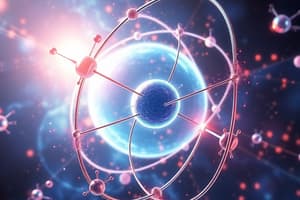Podcast
Questions and Answers
Why is NaClO4 a stronger oxidizing agent than NaClO3?
Why is NaClO4 a stronger oxidizing agent than NaClO3?
- It is a gas at room temperature.
- It has a lower oxidation number of Cl.
- Cl in NaClO4 has an oxidation number of +7. (correct)
- NaClO4 contains more oxygen atoms.
An ideal gas can undergo a phase transition.
An ideal gas can undergo a phase transition.
False (B)
What role does fluorine play in making fluorosulfuric acid (FSO3H) stronger than sulfuric acid?
What role does fluorine play in making fluorosulfuric acid (FSO3H) stronger than sulfuric acid?
Fluorine is more electronegative than oxygen, pulling electrons away from the O-H bond and increasing the partial positive charge on hydrogen.
The mutation of glutamic acid to valine in hemoglobin reduces its water solubility due to valine's ___________ side chain.
The mutation of glutamic acid to valine in hemoglobin reduces its water solubility due to valine's ___________ side chain.
Match the following compounds with their properties:
Match the following compounds with their properties:
What is the yield of lead (II) iodide, PbI2, produced in the reaction?
What is the yield of lead (II) iodide, PbI2, produced in the reaction?
The concentration of lead (II) ions, Pb2+, in solution at the end of the reaction is greater than 0 M.
The concentration of lead (II) ions, Pb2+, in solution at the end of the reaction is greater than 0 M.
What is the bond order of the BF molecule according to molecular orbital theory?
What is the bond order of the BF molecule according to molecular orbital theory?
The concentration of potassium ions, K+, in the solution is _____ M.
The concentration of potassium ions, K+, in the solution is _____ M.
Match the following ions with their concentrations in the resulting solution:
Match the following ions with their concentrations in the resulting solution:
In the reaction between lead (II) nitrate and potassium iodide, which species is the limiting reagent?
In the reaction between lead (II) nitrate and potassium iodide, which species is the limiting reagent?
The best Lewis structure for BF satisfies all octet rules for both atoms.
The best Lewis structure for BF satisfies all octet rules for both atoms.
What indicates a discrepancy between MO theory and experimental results in the bond order of BF?
What indicates a discrepancy between MO theory and experimental results in the bond order of BF?
What role does BeH2 play when reacting with hydrochloric acid in the aqueous phase?
What role does BeH2 play when reacting with hydrochloric acid in the aqueous phase?
KrH4 is expected to function as an acid due to the electron density concentrated on Kr.
KrH4 is expected to function as an acid due to the electron density concentrated on Kr.
Explain why Li3PO4 is highly insoluble despite being a Group 1 metal compound.
Explain why Li3PO4 is highly insoluble despite being a Group 1 metal compound.
Group 1 metal oxides react with water to produce __________.
Group 1 metal oxides react with water to produce __________.
Match the following properties or behaviors with the appropriate compound:
Match the following properties or behaviors with the appropriate compound:
Which molecular orbital corresponds to the HOMO in KrH4?
Which molecular orbital corresponds to the HOMO in KrH4?
HOMO in molecular orbital theory represents the highest occupied bonding orbital.
HOMO in molecular orbital theory represents the highest occupied bonding orbital.
What happens to the electron density in KrH4 during a reaction?
What happens to the electron density in KrH4 during a reaction?
Flashcards
Limiting Reagent in Reaction 2
Limiting Reagent in Reaction 2
The reactant that gets completely consumed in a chemical reaction, determining the maximum amount of product that can be formed.
Calculating Moles of KI
Calculating Moles of KI
Used to determine the amount (in moles) of Potassium Iodide (KI) present, needed for stoichiometric calculations within a reaction.
Calculating Moles of Lead(II) Nitrate
Calculating Moles of Lead(II) Nitrate
Method to determine the quantity of Pb(NO3)2 moles. Crucial for determining the limiting reactant.
Determining Limiting Reagent
Determining Limiting Reagent
Signup and view all the flashcards
Calculating Product Yield
Calculating Product Yield
Signup and view all the flashcards
Concentration of Ions in Solution (After Reaction)
Concentration of Ions in Solution (After Reaction)
Signup and view all the flashcards
MO Diagram (Molecular Orbital Diagram)
MO Diagram (Molecular Orbital Diagram)
Signup and view all the flashcards
Bond Order (MO Theory)
Bond Order (MO Theory)
Signup and view all the flashcards
NaClO4 vs NaClO3 Oxidation Strength
NaClO4 vs NaClO3 Oxidation Strength
Signup and view all the flashcards
Ideal Gas Law Limitations at Low Pressure
Ideal Gas Law Limitations at Low Pressure
Signup and view all the flashcards
Phase Transitions and Ideal Gases
Phase Transitions and Ideal Gases
Signup and view all the flashcards
FSO3H vs H2SO4 Acidity
FSO3H vs H2SO4 Acidity
Signup and view all the flashcards
Sickle Cell Anemia Mutation Effect
Sickle Cell Anemia Mutation Effect
Signup and view all the flashcards
HOMO
HOMO
Signup and view all the flashcards
LUMO
LUMO
Signup and view all the flashcards
BeH2 as a Lewis Base
BeH2 as a Lewis Base
Signup and view all the flashcards
Orbital Interaction in BeH2 + HCl
Orbital Interaction in BeH2 + HCl
Signup and view all the flashcards
KrH4 HOMO and LUMO
KrH4 HOMO and LUMO
Signup and view all the flashcards
KrH4 as a Base
KrH4 as a Base
Signup and view all the flashcards
Li3PO4 Insoluble in Water
Li3PO4 Insoluble in Water
Signup and view all the flashcards
Group 1 Metal Oxides Form Basic Solutions
Group 1 Metal Oxides Form Basic Solutions
Signup and view all the flashcards
Study Notes
Orbital Interactions
- Orbital interactions can be categorized as σ-bonding, σ-antibonding, π-bonding, π-antibonding, or non-bonding.
Aqueous Permanganate and Oxalate Reaction
- Aqueous permanganate ([MnO₄⁻]) reacts with aqueous oxalate ([C₂O₄]²⁻) under acidic conditions to produce gaseous carbon dioxide (CO₂) and aqueous manganese (II) ion (Mn²⁺).
- The balanced chemical equation is: 16H⁺(aq) + 2MnO₄⁻(aq) + 5[C₂O₄]²⁻(aq) → 10CO₂(g) + 2Mn²⁺(aq) + 8H₂O(l).
Concentration of Ions
- Solutions with higher concentrations of ions have greater numbers of ions in solution.
- For example, 1.50 M Al(NO₃)₃ has the greatest concentration of ions (6.00M) compared to the other solutions.
Crystal Field Theory
- Decreasing the oxidation state of a metal center does not lead to a greater crystal field splitting. This is because it leads to a decrease in metal-ligand bonding strength.
- Decreasing the electronegativity of a ligand's binding atom decreases a ligand's ability to donate electron density to the metal center, thus leading to a decrease in crystal field splitting.
- An increase in crystal field splitting makes the probability that a metal center will reside in a low spin electron configuration greater.
- The d₂² and dₓ²-y² orbitals participate in bonding, while the remaining d-orbitals are non-bonding in an octahedral arrangement.
Coordination Complexes
- Complex 1 is most likely to reside in a low-spin configuration.
- Complex 3 will have the greatest crystal field splitting.
- Complex 2 is most likely to absorb the lowest energy visible light. (E.g., red).
- A complex that absorbs 600 nm light appears blue.
Gas Containers
- Assuming ideal behavior, Container A (He) has the greatest pressure of gas.
- Assuming ideal behavior, Container C (NH₃) has the greatest density of gas.
- Assuming real behavior, Container C (NH₃) has the lowest pressure of gas.
- Assuming real behavior, all containers have the same greatest volume of available space.
Chemical Reactions
- Various chemical reactions and their classifications (precipitation, acid/base, redox) are described.
Boiling Point
- From a given set of structures, the compound with the highest boiling point should be selected.
Oxidation Numbers
- Oxidation numbers are assigned to the central atoms of given molecules.
Surface Tension, Viscosity etc analysis
- 1,4-dioxane is more miscible with hexane.
- 1,4-dioxane has lower surface tension and viscosity compared to glycerol.
- 1,4-dioxane has less adhesion to glass compared to glycerol.
Xenon Isotopes
- Molar mass of isotope 129 = 128.9 g/mol
- Molar mass of isotope 131 = 131.0 g/mol
Empirical Formula
- The empirical formula for a given compound can be determined via combustion analysis data and titration data.
Molecular Formula
- The molecular formula for a given compound is determined from the empirical formula and molar mass. A sample calculation is included
Lead (II) Oxide Reactions
- A set of molecular and ionic equations show the reaction of lead(II) oxide with nitric acid and potassium iodide. Product names are identified.
- The limiting reagent and amount of product are determined for the reactions.
- Concentrations of lead(II), potassium, and hydronium ions are calculated at the end of the reaction.
Molecular Orbitals
- Molecular orbital diagrams are drawn for BF and KrH4.
- The bond order is determined for these species
- The consistency of MO diagrams with known properties (bond order, charge distribution) are discussed.
Studying That Suits You
Use AI to generate personalized quizzes and flashcards to suit your learning preferences.
Related Documents
Description
Test your knowledge on key concepts in chemistry, including orbital interactions like σ and π bonding, aqueous reactions involving permanganate and oxalate, and the effects of ion concentration. Dive into crystal field theory to see how metal oxidation states affect bonding strength. Ideal for chemistry students exploring complex bonding theories.




